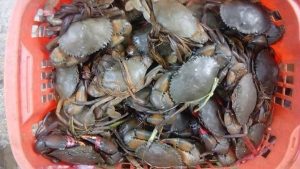28 March
The Myanmar Sustainable Aquaculture Programme will operate a crab hatchery on a trial basis in April in Labutta Township, Ayeyawady Region, with the help of a Malaysian crab farming company. Through the trial, MYSAP hopes to distribute crab larvae and share technology with breeders.
“At present, only wild-caught crabs are harvested in Myanmar. Wild crabs may become rare in the long term and so, we have initiated a crab hatchery and nursery business,” said Mr. Soh Chee Weng, assistant general manager, TEXCHEM Group of Companies.
“We have prepared for everything. The hatching operation will begin next month. In May, we will distribute larvae of crabs. We have not decided the price of crab larvae for now, as we still haven’t estimated the overall cost of production. Sure, the larvae will be priced at a rate affordable to the breeders. Around 100,000 crab larvae are likely to be produced,” said Mr. Soh Chee Weng.
“Four species of crabs are currently found in Myanmar. Of them, two wild-caught crab species will be bred experimentally, and the Scylla paramamosain species will be primarily farmed. The crab hatchery can increase the current annual production by 10 times. After passing the larvae stage, the crabs will become marketable in two months, once they weigh 100 grams,” according to officials.
“There is no larvae production in Myanmar. Breeders farm naturally-caught crab larvae. However, natural production of crab larvae cannot fulfil requirements. The Malaysian company has research experience in Viet Nam. Breeders will get know-how on crab production and nursery,” said U Soe Tun, a consultant with MYSAP (Saltwater Fishery).
MYSAP 2017-2021 is being jointly implemented by the Fisheries Department and the German International Cooperation (GIZ), with 22.25 million euros funded by the European Union and GIZ.
The Myanmar Sustainable Aquaculture Programme (MYSAP) supports the sustainable expansion of the aquaculture sector to help realize its potential for food security, nutrition, and livelihoods.
The new project aims to contribute to the crab farming industry as more than 100 million crabs are being caught from their habitats in the wild, and excessive capture is leading to the deterioration of the wild crab population.
“Farming lakes can benefit from the emergence of a hatchery. The number of breeders will increase once crab larvae are supplied through natural capture and the hatchery. This can help crab farming businesses,” said U Win Naing, the chair of the Labutta District Crab Entrepreneurs Association.
Earlier, the Department of Fisheries did not allow transport and trade of crabs weighing below 100 grams. Now, the ban has been relaxed to a certain extent, and trade has been permitted for some sizes of crabs. This has been done to increase the country’s revenues and create jobs for locals through the emergence of crab farming companies.
“The TEXCHEM company is trying to operate a hatchery with MYSAP’s assistance, and this is not for wild-caught harvesting. If this business reaps successful results, it can minimize harvesting of wild crabs and increase the crab population. This production technology is not in our hands yet. Once we receive it, we will support local breeders. As the business can help earn foreign currency, our department is working on it,” said U Thet Oo, who is currently serving with the Myaungmya and Labutta districts’ Fisheries Departments.
Over the long term, harvesting of wild crabs can harm aquaculture. Therefore, the Fisheries Department planned to prohibit capturing of crabs for three months. After negotiations with businesspersons and breeders from Pathein town and experts, the department decided to limit capturing of crabs in March.
Although there are around 400 acres of crab farms in Labutta District, one foreign corporate, local companies, and local breeders are currently utilizing only 280 acres.
By Aye Yamone (Translated by Ei Myat Mon)



